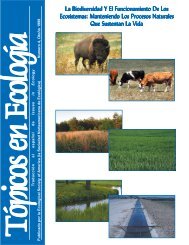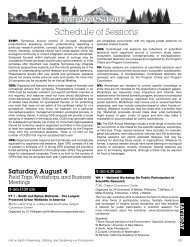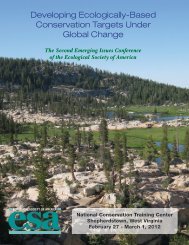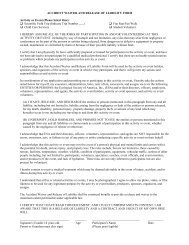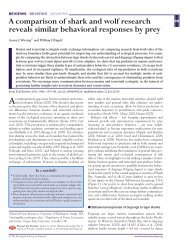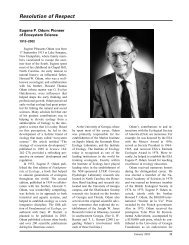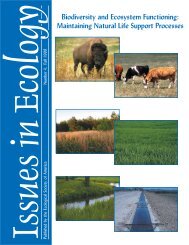Printed Program (PDF) - Ecological Society of America
Printed Program (PDF) - Ecological Society of America
Printed Program (PDF) - Ecological Society of America
You also want an ePaper? Increase the reach of your titles
YUMPU automatically turns print PDFs into web optimized ePapers that Google loves.
TUESDAY<br />
8 am-11:30 am<br />
University <strong>of</strong> Wisconsin - Madison. Crowdsourcing<br />
ecological research: Using the Trails Forward simulation<br />
platform and video game to address conservation issues.<br />
9:40 AM Break<br />
9:50 AM COS 42-6 Hart, EM and L Avilés, University <strong>of</strong> British<br />
Columbia. The interplay between random catastrophes<br />
and Allee effects on the dynamics <strong>of</strong> local populations in<br />
a metapopulation.<br />
10:10 AM COS 42-7 Smith, DM1 , DM Finch1 , DA Lytle2 and<br />
DM Merritt3 , (1)USDA Forest Service Rocky Mountain<br />
Research Station, (2)Oregon State University, (3)USFS<br />
Watershed, Fish, and Wildlife & CSU Natural Resource<br />
Ecology Laboratory NRRC. Fire and flood in the bosque:<br />
a cottonwood population model for flow-restricted<br />
streams <strong>of</strong> the <strong>America</strong>n Southwest.<br />
10:30 AM COS 42-8 Scranton, K1 , J Knape2 and P de Valpine1 ,<br />
(1)University <strong>of</strong> California - Berkeley, (2)University<br />
<strong>of</strong> California - Berkeley, Berkeley, CA. Estimating a<br />
population model for stage-structured cohort data with<br />
individual heterogeneity in development.<br />
10:50 AM COS 42-9 Rodhouse, TJ1 , PC Ormsbee2 , KM Irvine3 ,<br />
LA Vierling4 , JM Szewczak5 and KT Vierling4 , (1)National<br />
Park Service, (2)US Forest Service, (3)US Geological<br />
Survey, (4)University <strong>of</strong> Idaho, (5)Humboldt State<br />
University. Annual turnover in bat occupancy patterns:<br />
predictions from life history theory with implications for<br />
conservation and monitoring.<br />
11:10 AM COS 42-10 Morrison, TA1 , MJ Kauffman2 , AD Middleton1 and DE McWhirter3 , (1)University <strong>of</strong> Wyoming, (2)United<br />
States Geological Survey, Wyoming Cooperative Fish<br />
and Wildlife Research Unit, (3)Wyoming Game and Fish<br />
Department. Heading for a cliff: Can dramatic declines in<br />
elk recruitment cause lagged population declines?.<br />
COS 43 - Mutualism And Facilitation II<br />
Portland Blrm 255, Oregon Convention Center<br />
8:00 AM COS 43-1 Suwa, T1 , E Grman2 , R Prunier2 and JA Lau2 ,<br />
(1)Michigan State University and W.K. Kellogg Biological<br />
Station, (2)Michigan State University. Does speciesspecific<br />
context-dependency in mutualisms explain<br />
community response to environmental change?.<br />
8:20 AM COS 43-2 Morales, MA1 and AG Zink2 , (1)Williams<br />
College, (2)San Francisco State University. Mechanism<br />
<strong>of</strong> agreggation in an ant-tended treehopper.<br />
8:40 AM COS 43-3 Afkhami, ME and SY Strauss, University <strong>of</strong><br />
California, Davis. Mutualist-mediated niche expansion<br />
and differentiation in a grass-fungal endophyte symbiosis:<br />
Linking an experimental test <strong>of</strong> drought tolerance to<br />
rangewide patterns <strong>of</strong> mutualist-mediated niche effects.<br />
9:00 AM COS 43-4 Yoo, HJ and DA Holway, University <strong>of</strong><br />
California, San Diego. <strong>Ecological</strong> effects <strong>of</strong> multi-species,<br />
ant-hempiteran mutualisms in citrus.<br />
9:20 AM COS 43-5 Biswas, SR and HH Wagner, University <strong>of</strong><br />
Toronto. Temporal dimension <strong>of</strong> the Stress Gradient<br />
Hypothesis at the intraspecific level.<br />
9:40 AM Break<br />
9:50 AM COS 43-6 Hembry, DH, L Atkinson, C Guo, EA Newman<br />
and RG Gillespie, University <strong>of</strong> California, Berkeley.<br />
Coevolutionary diversification and network structure <strong>of</strong> a<br />
specialized pollination mutualism on oceanic islands.<br />
10:10 AM COS 43-7 Keller, KR, Michigan State University. The<br />
role <strong>of</strong> resource mutualisms and intraspecific variation<br />
during succession.<br />
10:30 AM COS 43-8 Amato, KR1 , CJ Yeoman1 , AD Kent2 , N<br />
Righini1 , F Carbonero1 , A Estrada3 , HR Gaskins1 , RM<br />
Stumpf 1 , S Yildirim 1 , M Torralba 4 , M Gillis 4 , BA Wilson 1 ,<br />
KE Nelson 4 , BA White 1 and SR Leigh 1 , (1)University <strong>of</strong><br />
Illinois at Urbana-Champaign, (2)University <strong>of</strong> Illinois, (3)<br />
Universidad Nacional Autónoma de México, (4)J. Craig<br />
Venter Institute. Spatial and temporal variation in the gut<br />
microbiome <strong>of</strong> wild, black howler monkeys (Alouatta pigra).<br />
10:50 AM COS 43-9 Brown, BL 1 , RP Creed Jr. 2 , J Skelton 1 , KJ<br />
Farrell 2 and M Thomas 2 , (1)Virginia Tech, (2)Appalachian<br />
State University. Fickle food on a shifting plate: Variable<br />
benefits and partner control mechanisms in a crayfishannelid<br />
cleaning symbiosis.<br />
11:10 AM COS 43-10 Hannon, LE and DL Finke, University <strong>of</strong><br />
Missouri. A role for generalists in the pollination <strong>of</strong><br />
Krameria erecta oil flowers in central Arizona?.<br />
COS 44 - Parasitism And Host-Parasite Interactions<br />
Portland Blrm 256, Oregon Convention Center<br />
8:00 AM COS 44-1 Torchin, M 1 , O Miura 2 and R Hechinger 3 ,<br />
(1)Smithsonian Tropical Research Institute, (2)Kochi<br />
University, (3)UC Santa Barbara. Parasite species<br />
richness in marine snails increases with latitude in both<br />
the Atlantic and Pacific Oceans.<br />
8:20 AM COS 44-2 Nabity, PD 1 , MR Berenbaum 1 and EH<br />
DeLucia 2 , (1)University <strong>of</strong> Illinois, (2)University <strong>of</strong> Illinois<br />
at Urbana-Champaign. Testing the extended phenotype<br />
hypothesis as phylloxera induce stomata and reorganize<br />
metabolism in grapes.<br />
8:40 AM COS 44-3 Malfi, RL and TH Roulston, University <strong>of</strong><br />
Virginia. Patterns <strong>of</strong> parasite infection in bumble bees<br />
(Bombus spp.) <strong>of</strong> the northern Shenandoah Valley in<br />
Virginia.<br />
9:00 AM COS 44-4 Wood, CL 1 , F Micheli 1 , M Fernández 2 ,<br />
S Gelcich 2 , JC Castilla 2 and J Carvajal 3 , (1)Stanford<br />
University, (2)Universidad Católica de Chile, (3)<br />
Universidad de los Lagos. Epidemiological and<br />
ecological effects <strong>of</strong> fishing on parasites <strong>of</strong> fished host<br />
species.<br />
9:20 AM COS 44-5 Mordecai, EA 1 , AG Jaramillo 2 and JE<br />
Ashford 2 , (1)University <strong>of</strong> California-Santa Barbara, (2)<br />
University <strong>of</strong> California, Santa Barbara. Competition –<br />
colonization trade<strong>of</strong>fs promote coexistence in salt marsh<br />
trematode parasites.<br />
9:40 AM Break<br />
9:50 AM COS 44-6 Hersh, MH 1 , MA Previtali 2 , SL LaDeau 3 , F<br />
Keesing 4 and RS Ostfeld 3 , (1)Bard College and Cary<br />
Institute <strong>of</strong> Ecosystem Studies, (2)Universidad Nacional<br />
del Litoral, (3)Cary Institute <strong>of</strong> Ecosystem Studies, (4)<br />
Bard College. Effects <strong>of</strong> variable larval tick burdens on<br />
survival <strong>of</strong> white-footed mice (Peromyscus leucopus).<br />
10:10 AM COS 44-7 Koprivnikar, J and JC Redfern, Brandon<br />
University. Life history and ecological aspects <strong>of</strong> larval<br />
amphibian behavioral consistency.<br />
10:30 AM COS 44-8 Arnold, E 1 and G Devevey 2 , (1)University <strong>of</strong><br />
Illinois at Chicago, (2)University <strong>of</strong> Pennsylvania. From<br />
the perspective <strong>of</strong> a parasite: What factors determine<br />
success for a tick?.<br />
10:50 AM COS 44-9 Smith, NF 1 and JH Cohen 2 , (1)Eckerd<br />
College, (2)University <strong>of</strong> Delaware. Light-mediated<br />
behavior <strong>of</strong> marine parasitic larvae: Adaptations to<br />
enhance transmission success.<br />
11:10 AM COS 44-10 Sargent, LW, K Towle, L Callahan and DM<br />
Lodge, University <strong>of</strong> Notre Dame. Host manipulation by<br />
a trematode parasite (Microphallus sp.) favors invasive<br />
rusty crayfish (Orconectes rusticus) in competition with<br />
congeners.<br />
74 ESA 97th Annual Meeting, August 5 - 10, 2012, Oregon Convention Center



